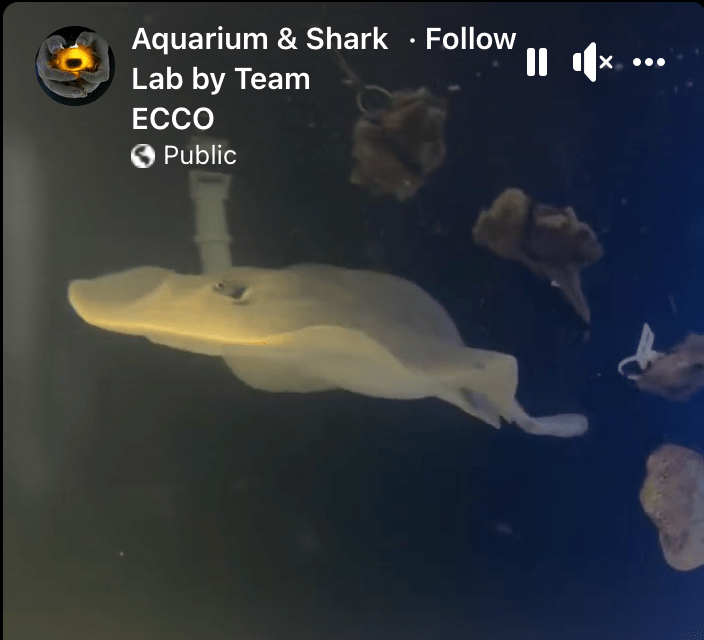|
Getting your Trinity Audio player ready...
|
Read our updates to this story here.
One day in March, Larry Boles, director of the aquarium science program at Oregon Coast Community College, went to post on Facebook about Charlotte, a stingray in North Carolina allegedly impregnated under mysterious circumstances.
Boles had commented on posts about Charlotte before, as had other experts, to say he was troubled about the spread of bad information about marine science as it related to the stingray, and he wanted to set the record straight.
“I went to the comments section with the idea that the least thing I can do is correct people’s misunderstandings about the biology, right?” Boles said.
That’s when Boles says he realized that the Aquarium & Shark Lab by Team ECCO in Hendersonville had blocked him. (A spokesperson for ECCO denied blocking scientists, but Boles provided screenshots that backup his claim.)
Charlotte, a California round ray, floated into Internet stardom in February after aquarium owner Brenda Ramer sent a message to a private aquarist listserv announcing that Charlotte was pregnant and allegedly due to give birth any day. Charlotte had not encountered a male stingray in years; the message claimed that Charlotte had either undergone parthenogenesis—asexual reproduction—or that the father was one of two bamboo sharks who shared her tank.
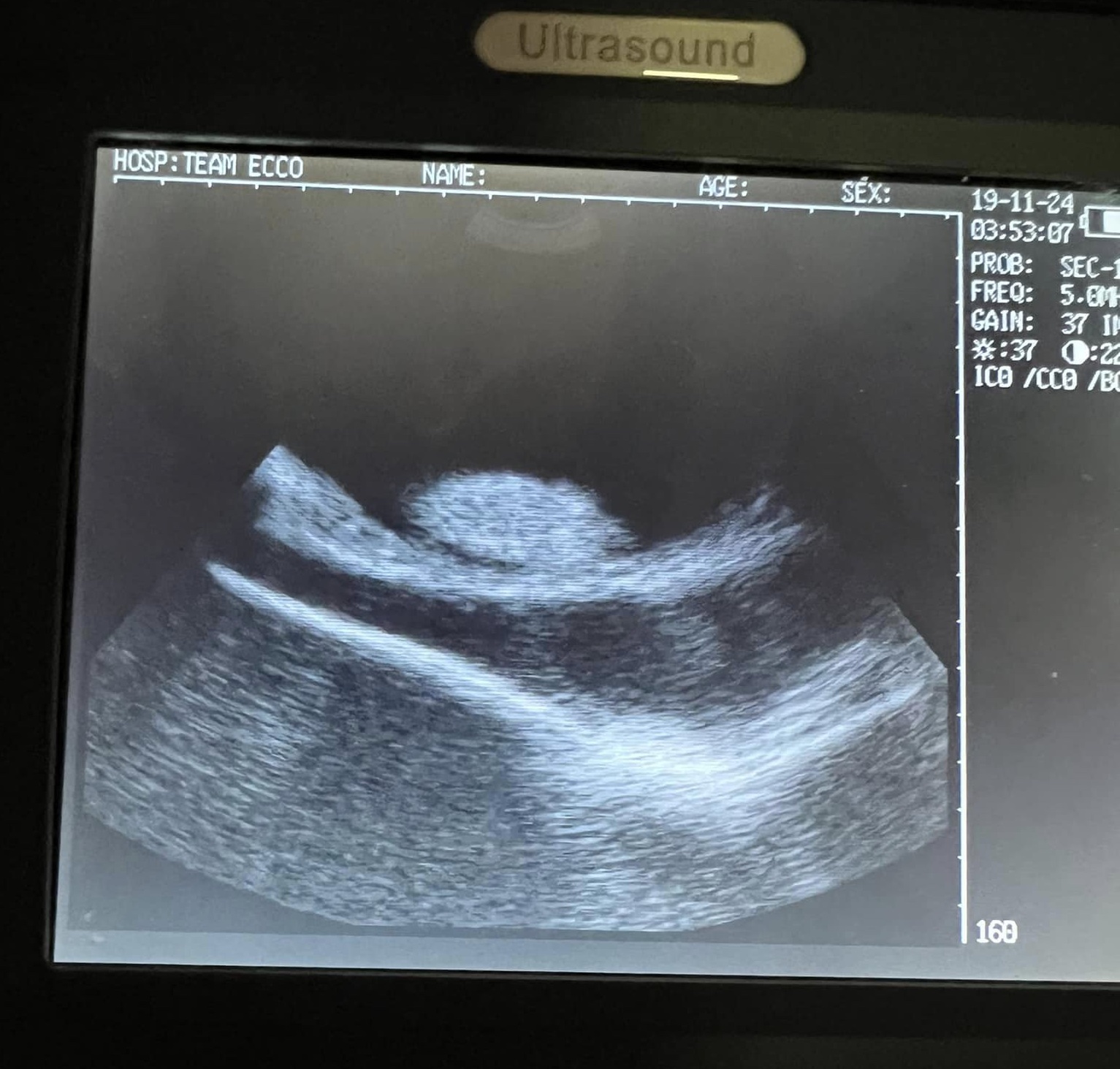
The national and international press went wild. Discussions of “shark rays” and a virgin birth blew up on Facebook and TikTok, and ECCO’s videos garnered millions of views. Although experts quickly debunked the shark theory as scientifically impossible, Charlotte’s fans waited eagerly for her to give birth.
Months went by without pups, and the aquarium’s social media updates became more sporadic and vague. The behavior of the aquarium staff also became increasingly bizarre. Boles and others say Ramer and her team blocked people who asked questions or shared scientific information.
Then on May 16, ECCO promised an update from Charlotte herself, a post that they deleted later that day. They posted again the next day: “Charlotte continues to appear healthy and has shown little to no change in any of her behaviors or temperment (sic). There is no new information to share at this time.” The Assembly asked ECCO’s PR representative via email why they’ve stopped frequent updates, and they replied, “We have made updates and shared news as we have been able to. We are waiting to have full notes from the veterinary team to provide additional updates.”
Many on the internet were now wondering what marine biologists had been for months: What is really going on with North Carolina’s most famous stingray?
‘Like the Tide’
Hendersonville, North Carolina is a mountain town of 15,000 about an hour south of Asheville. Its cute main street is lined with toy stores, antique malls, and coffee shops.
In 2009, Brenda Ramer, a former public school teacher and volunteer with nonprofit Oceans for Youth, started ECCO with the goal of educating the children about the sea. The facility moved into its current location in 2011.
“Like the tide, we are in a continuous motion saying ‘Why not’ and ‘What if’ as our students and interns research ideas, document, and defy existing standards,” says ECCO’s website. ECCO is a privately owned nonprofit, and it is not accredited by the Association of Zoos and Aquariums.
On February 2, Ramer sent a message to a private aquarium discussion forum declaring a “science ‘miracle’” and “once in a lifetime event”: Charlotte was pregnant with up to four pups. The post said that the aquarium had known about the pregnancy since September, that two vets had looked at the ultrasound and confirmed eggs, and that the aquarium now had video of the pups “hatched and free swimming inside the birth cavity in Charlotte’s back.”
They followed up with a Facebook post on February 6, including sentences such as “The really amazingzi g thing Is we have e no male ray!” (The aquarium fixed the typos in the post after a roast from late night host Jimmy Kimmel.)
On February 8, Ramer went live on Facebook to show Charlotte’s ultrasound. Ramer said that until the pups were born, she’d assume they were stingrays, but also mentioned the shark-ray theory. “Oh my gosh, she had bite marks,” Ramer says. “Sharks bite when they mate. There’s a potential she mated with one of these sharks.”
Much of the video consists of Ramer pointing at grainy grayscale ultrasound images. “If there’s somebody out there watching who reads ultrasounds for a living, please chime in,” she says in the video. “It’s kind of like trying to read Chinese, isn’t it?”
The media went wild, with news outlets from NPR to the Smithsonian to the United Kingdom’s Daily Mail reporting on Charlotte.
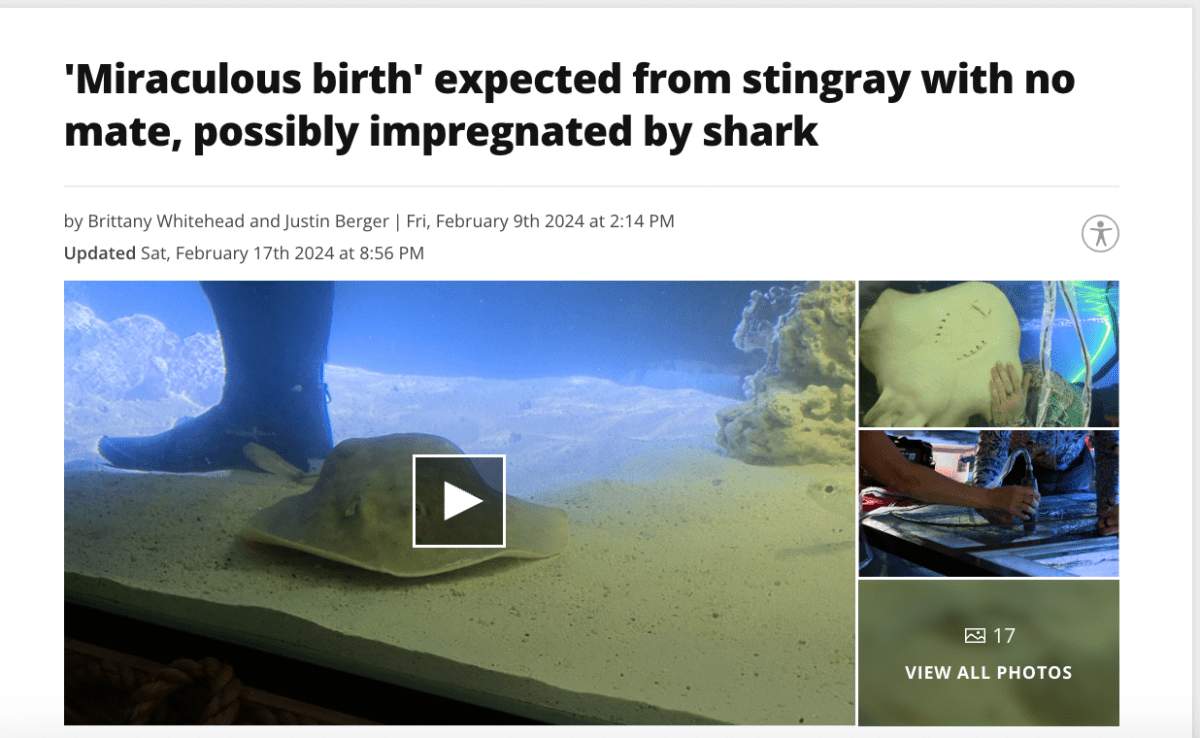
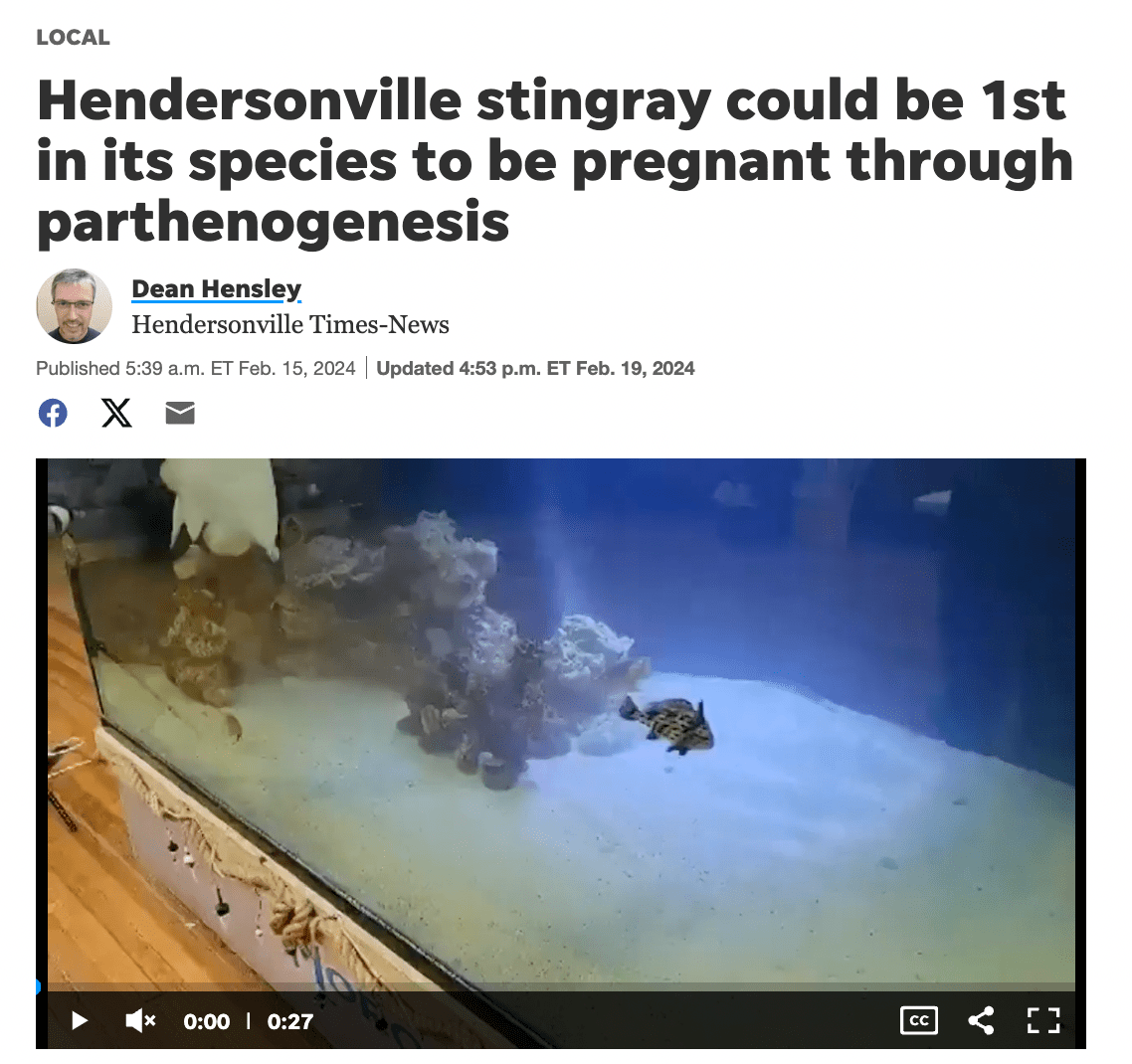
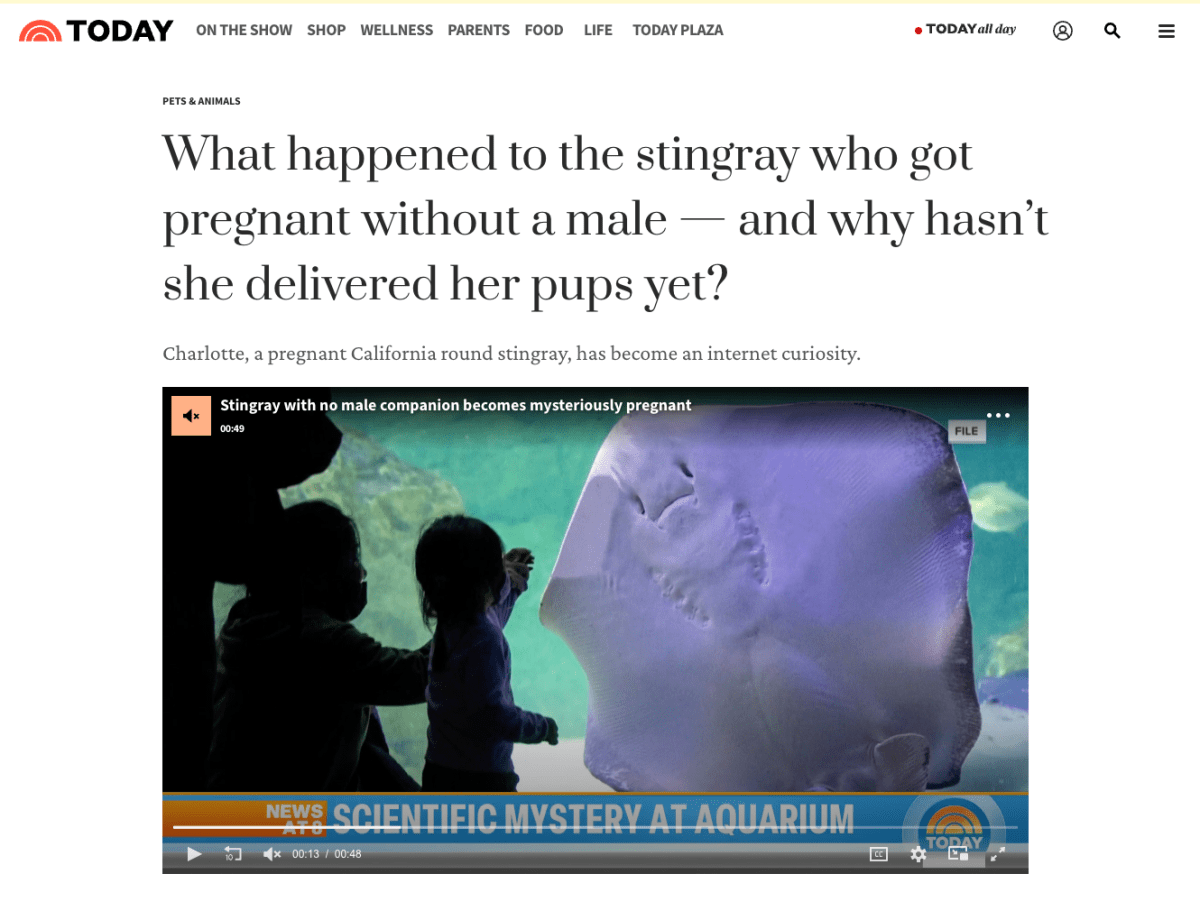

But the aquarium and marine science community was troubled. First, they were worried about Charlotte’s welfare. “Really from the beginning, all I said, and all my colleagues said, was that this animal needs to see a veterinarian,” said Boles. He was careful to point out that the aquarium could be working with a vet behind the scenes, and that he’s not an expert on stingrays–just an experienced marine scientist with more freedom to speak out than others whose employers may bar talking to the media.
Marine biologists were also disturbed by the shark-ray hybrid claim. David Shiffman, a marine conservation biologist at Arizona State University and a widely followed public science communicator, said he first learned about Charlotte when relatives and friends asked him about the stingray who mated with a shark—an idea that Shiffman knew was “cuckoo banana pants.”
“Sharks and rays are separated by as many millions of years of evolution as humans and snakes,” he said. “If a human tried to mate with an anaconda, a lot of things would probably happen. But one of those things would not be a half-human, half-anaconda baby.”
“It’s click-bait garbage,” said Demian Chapman, a senior scientist at the Mote Marine Laboratory and Aquarium in Florida, who first discovered parthenogenesis in cartilaginous fish in 2007. Chapman and Shiffman were disturbed both by the absurdity of the claim and that the aquarium was cheerfully propagating it.
“When challenged, they said, well, scientists don’t know everything and we make new discoveries sometimes,” Shiffman said. “There are some things about the universe that we know to be true. And it is perhaps not great that an aquarium responded in that way, given the supposed role of zoos and aquariums and science museums in educating the public.”
Boles reached out to Ramer directly, advising her to work with an aquatic animal veterinarian to examine Charlotte. Over the next few weeks, ECCO tiptoed away from the shark paternity theory in comments online, but never retracted the claim. That’s when a number of scientists say ECCO started blocking experts and laypersons alike who asked questions or cast doubt on the narrative.
In between posts about Charlotte’s Amazon wishlist for her “nursery” and the “We ❤️Charlotte” T-shirts available in the aquarium gift shop, most of ECCO’s updates on the now-famous stingray showed a whole lot of nothing: Charlotte careening around her tank, posts about what she ate for dinner.
“If a human tried to mate with an anaconda, a lot of things would probably happen. But one of those things would not be a half-human, half-anaconda baby.”
David Shiffman, marine conservation biologist
By mid-March, Charlotte had allegedly been pregnant for six months, according to the aquarium’s timeline, which claimed she’d conceived in September. The average gestation length for a round ray is three to four months, which would mean Charlotte was already overdue.
Her story drew people from all over to Hendersonville. “It’s definitely put a spotlight on the town,” said Jill Harger, an employee at a clothing store on the other side of Main Street. “Some days the traffic on the other side of the street is backed up for nearly half a block,” said Jesse Nelson, who works at the Silver Fox Gallery down the block. Commenters on social media talked about planning trips to see Charlotte.
Even in February, the aquarium was appealing to patience. In a February 25 Facebook post, ECCO stated that due to the parthenogenesis, “This is not a typical ray pregnancy. We can find no precedent or data that gives a specific gestation time frame.”
While experts say parthenogenesis can throw off a pregnancy timeline slightly, there’s no reason for it to last months and months.
Then March turned to April, and her online fans started demanding: Where are the pups? They grew more concerned when what looked like an ulcer appeared on Charlotte’s back in videos from April. The story changed further: in an Instagram comment made by ECCO on April 27, “four pups” changed to “a pup.”
“They keep changing the story, bringing in new possibilities. That is not the sign of a normal scientific veterinary process,” Boles said. “That’s a sign of somebody who has an answer and keeps building new stories to support the answer they want to be true.”
So, I decided to go to Hendersonville to see for myself what was up.
Feeding Time
The aquarium is located in an unassuming storefront with a blue awning. A tortoise loiters in the window, and the awning proclaims, “Bringing the Sea to WNC.” You could be forgiven for thinking the place was a pet store, based on its location and ambience.
Inside, I asked the teenage volunteers behind the counter if I could tour the aquarium and interview staff. I had emailed Ramer for an interview before heading to Hendersonville, but heard nothing back. They told me I couldn’t go in as a reporter without permission from the aquarium’s pro-bono PR representative, a woman named Kate Foley who lives in Arizona. I emailed Foley and asked the volunteers if, in the meantime, I could buy a ticket and enter the aquarium as a normal guest.

“You’re definitely allowed to go back there,” one said.
About 20 adults and children were crowded into the one-room aquarium that afternoon, watching a live presentation about Epa, a female bamboo shark who shares Charlotte’s tank. The walls were lined with unlabeled tanks full of tropical fish and coral, along with fun facts and the kind of ocean kitsch you might see at a beach restaurant: nets, buoys, a weathered sign stating, “Always be yourself, unless you can be a mermaid.” On a wall near the back hung a quilted square bearing an image of ECCO’s most famous resident with the caption, “Charlotte, captivating the world.”
Then there was Charlotte herself. To my untrained eye, she looked lively. A putty gray creature about the size of a hubcap, she fluttered around her tank, her mouth opening and shutting, her gills dilating as she swam. Her midsection bulged, like an overstuffed dumpling.
“She didn’t have a baby yet, huh?” said one visitor in passing. Another pointed her camera at the glass, exhorting Charlotte to smile as she snapped a picture. A little boy held his hand up as Charlotte fluttered up to the edge of her tank.
I wasn’t allowed to conduct any interviews in the aquarium, and I’d seen all there was to see, so I decided to leave and come back at 3:15 for the ray feeding, hoping to learn more official information about Charlotte. I did a person-on-the-street interview outside on the sidewalk with visitors who’d come to pay homage to Charlotte, then settled down on a public bench to wait.
That’s when I was approached by a member of the Hendersonville police. Officer Marianna Tinoco asked if I was a news reporter, then explained that they’d received a call that I was harassing people. I told her I’d only interviewed one couple who’d been eager to talk. Tinoco said I could carry on with my work, as long as I wasn’t harassing anyone, then she and a second officer walked into the aquarium.
When they came back out, they told me that Ramer wanted them to book me for “trespassing.” They weren’t going to charge me with anything, they said—I looked “sweet.” But if I went back into the aquarium, they would have no choice but to arrest me.
This was my second dust-up with police in 15 years of journalism. The last one was reporting on neo-Nazis in Germany. This one was about a stingray.
I requested the recording and report from the 911 call a few days later. In it, an unnamed female caller claimed a reporter was outside “harassing” guests and an officer was needed to “make sure everybody’s safe out there.” They had young volunteers, the caller said, who “didn’t need to see this.”
I also tried Foley again, the PR person I’d been directed to at Epic Consulting Group, an Arizona-based firm that seems to work mainly with basketball clients. (Editor’s Note: After our initial publication, we learned Foley is Ramer’s daughter.)
For 20 minutes, I asked Foley several variations of the question, “Why did the aquarium call the police on me?”
I couldn’t get a very specific answer: “Every company has safety concerns,” “Inside the aquarium, that’s what your experience was,” and “If you’re telling me you’re going to write a story about what happened after you left, that’s between you and the Hendersonville Police Department.” As for my questions about Charlotte herself, she directed me to send them via email.
I sent a litany of questions about Charlotte, and repeated my question about the police. In response to the questions about Charlotte, she wrote, “I will process those as we do all media requests.” Regarding the cops: “I have no idea what you are speaking of.”
What Is Happening?
On the phone, Foley had one more comment in response to my question about the police: “Hopefully the story’s goal is to have people be excited about something and talk about marine biology.”
This statement echoed ECCO’s past responses to naysayers. “I am going to ask that you please do not use our platform for wonder and research to make a personal stand or comments to prove yourself and your knowledge to other readers,” the aquarium said in a February post. “Charlotte is a special and lovely fish. We are sharing her experience with you as a way to learn together. It is our gift. Please, do not disqualify our event. Just because something has not happened or has not been documented does not make it impossible. Science is discovery.”
Wanting to understand more about the science, I asked Foley if Charlotte has regular vet care and if anyone has taken an ultrasound of her since February. “She has daily physical and visual exams,” she replied over email, and “multiple images have been taken and reviewed.”
She did not answer questions like, “What is happening with Charlotte and her pregnancy currently?” “Have the aquarium vet or outside scientists examined her and tried to confirm what’s going on?” or “Could the aquarium have been wrong about the pregnancy?”
“Charlotte is a special and lovely fish. We are sharing her experience with you as a way to learn together. It is our gift. Please, do not disqualify our event.”
ECCO Facebook post
Outside scientists can’t say for sure what’s going on with Charlotte, since as far as the public knows, no vets or marine animal experts have examined her. ECCO is correct that elasmobranchii, a class of cartilaginous fish that includes both sharks and rays, are fascinating creatures whose reproductive adventures often defy human expectations.
“Sharks and rays have some of the most diverse and I’d go so far as to say, weird reproductive strategies of anything in the animal kingdom,” said Shiffman, the biologist and public science communicator at ASU. Some eat their siblings in utero; some females can store sperm for up to four years after mating and impregnate themselves when they feel like it; some mate with multiple males and give birth to litters of half-siblings.
Then there is, of course, parthenogenesis, the process by which an animal’s egg develops into offspring without fertilization from a male partner. Some scientists describe parthenogenesis as a last-ditch effort to pass on genes to the next generation, potentially because an animal is living in adverse conditions or is isolated from males.
Chris Lowe, a professor in marine biology and director of the Shark Lab at California State University, Long Beach, said that pups produced through parthenogenesis often don’t survive. With only one gene pool to draw on, parthenogenetic offspring are more susceptible to genetic mutations—it’s an extreme form of inbreeding. Lowe said it’s possible that Charlotte was pregnant, but her body reabsorbed the nutrients from the embryos.
There’s also a process known as “diapause,” through which a stingray can pause a pregnancy if conditions aren’t right—although Boles said that would usually happen early in gestation, not when birth is imminent. Water temperature and stress can also impact the length of gestation, said Lowe. If Charlotte is stressed or in colder water than normal, her gestation might last longer.
But Demian Chapman said we are already at the upper limits for stingray gestation. “This would be about double what their gestation period is,” he said. “I don’t know that this rules out pregnancy, but at some point the time will rule it out. A gestation that’s twice the norm is unusual, obviously.” Boles said if Charlotte were pregnant at some point, her bulge might be caused by calcified eggs or deceased embryos.
There’s also a possibility that Charlotte was never pregnant at all. In April, ECCO said on Facebook that they sent a sonogram to an expert and that it “looked good.” But the only time the aquarium has publicly shown an ultrasound was in February. At that time, they said that Dr. Rob Jones, a veterinarian from Australia, had looked at the imaging and confirmed there were four eggs.
From the beginning, Boles wondered if Charlotte was suffering from reproductive disease, a term that encompasses a variety of conditions common in older female stingrays. Most studied in Southern stingrays, but prevalent in other breeds too, reproductive diseases can lead to cystic ovaries and engorged uteruses. Scientists and aquarists have been studying these conditions for years: in a 2013 presentation, vets and aquarists revealed research on how two out of nine female captive Southern stingrays presented with a bulge due to fluid buildup in the reproductive system.
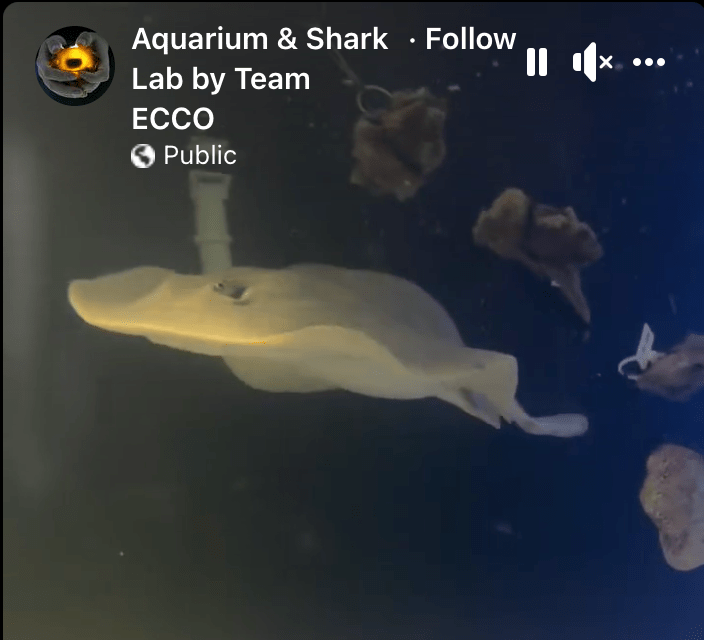
Lowe said swelling, tapeworms, or parasites might also cause Charlotte’s girth—or overindulgence. “In our early days of studying round stingrays, we actually saw males that looked that way and it turns out that that was all food,” Lowe said.
If Charlotte really had gotten pregnant through parthenogenesis, it would be the first recorded case for a California round stingray—interesting, but not a “miracle.” “It could have been published, but it wouldn’t have been something that shook science to its core,” said Chapman.
On May 8, ECCO said in a Facebook post that they had “aligned with expanded support and medical teams of qualified veterinarians for additional testing.” But they haven’t shared results from these tests or indicated whether these vets have actually examined Charlotte in person. And some of the conditions mentioned as possibilities by vets and scientists could lead to a grim outcome for Charlotte, according to Boles. If her bump is caused by a solid mass, surgery could be the only cure. Fluid build-up and internal hard masses can lead to infection, which can cause death by sepsis if left untreated by antibiotics. Boles stressed that while all of these are possibilities, it’s important not to try to diagnose Charlotte from afar.
It would be easy for the aquarium to dispel all of this speculation. Lowe said blood tests can show whether a ray is about to give birth based on hormone levels. And Chapman said there are many outside experts who could bring in a portable ultrasound machine and provide a definitive answer.
Charlotte’s Web
On my afternoon in Hendersonville, I met Brystal Gwinn, a Baltimore resident who was vacationing with her boyfriend. Gwinn is a bubbly Charlotte stan who got into the stingray, like so many, via TikTok.
But by May, she was getting worried about her.
“It’s a mystery, right?” said Gwinn. “Nobody really knows what’s going on. Is there something weird going on with sharks in the tank? Is she actually here? Did the aquarium post it just to get people to come in?”
Gwinn said she has no idea what’s really going on with Charlotte, but she was happy to see her alive and looking like a “stuffed ravioli” in her tank.
But another TikTok fan who visited said her alarm bells went off. Stephanie Rzonca, a needlepoint artist from western North Carolina, said she was put off by the staff’s behavior. “I was taking pictures, and they were over my shoulder like, ‘Make sure that’s not a video,’” she said. “I thought that was bizarre behavior.”

Rzonca also found the aquarium’s dim lights and unlabeled exhibits disconcerting. To her, it felt like a sideshow. “I knew she was a very public figure. I was like, this doesn’t seem normal or right. Something is off here.”
After she returned home, she started posting her own TikToks questioning what she’d seen and interviewing marine biologists to try to figure out what’s going on. She’s racked up thousands of views from others who are outraged and concerned.
There’s also a growing chorus of people who want to see something done to help her—with whatever it is that’s happening biologically. But animal welfare laws in North Carolina apply to mammals, birds, reptiles, and amphibians. They don’t apply to fish. That means that calling authorities about animal abuse would be unlikely to yield results.
Boles said you can find places like ECCO everywhere in America. For example, earlier this year, ABC News investigated a chain of mall aquariums where guests had allegedly been injured and animals were allegedly living in subpar conditions.
“I know it’s not fun for people to hear, but, you know, what’s unusual about this case is not the condition of the animal, it is the attention that this case has received,” Boles said. Because ECCO is not AZA accredited, they don’t have to meet accreditation standards, which include maintaining a contract with a vet for bimonthly inspections.
“I have attempted on a few occasions to encourage people to look at this as a bigger issue and not just a single animal,” Boles said. “Places like this exist all over the country.”
Other aquarists said it’s important to give small aquariums like ECCO the benefit of the doubt. Some are trying their best to provide good homes for their charges; some can’t afford veterinary care.
Boles thinks ECCO has been given the benefit of the doubt for too long. “I certainly hope there’s a healthy outcome for this animal,” he said. “It’s just harder and harder to see how that’s gonna happen as time goes on.”
Read Our Update
Charlotte the Stingray Isn’t Pregnant After All
Emily Cataneo is a writer and journalist based in Raleigh. Her work has appeared in the New York Times, The Guardian, Slate, Atlas Obscura, Undark, and many other venues. She is a co-founder of Raleigh’s Redbud Writing Project.



